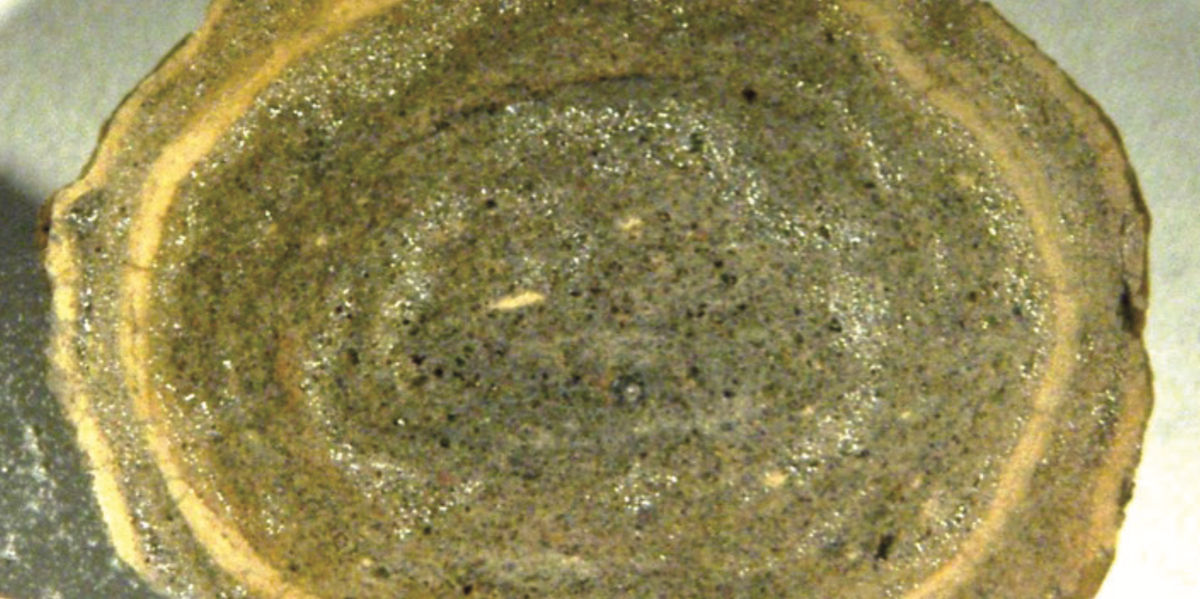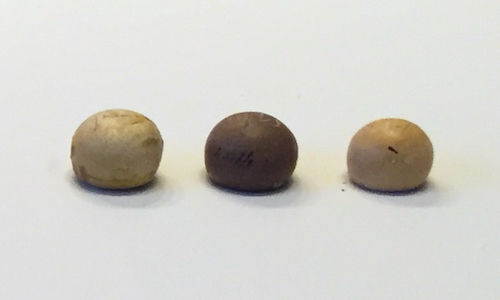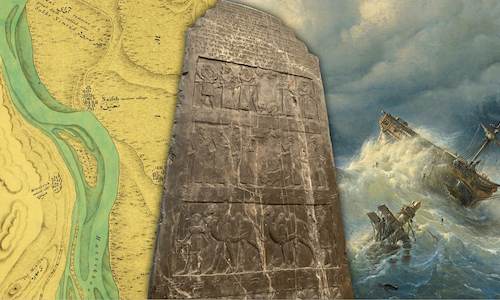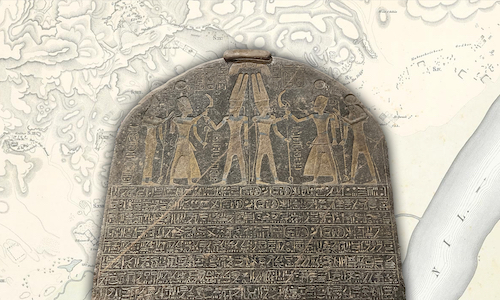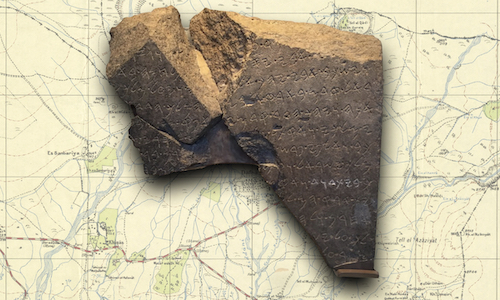A critical assessment of the scientific explanation for the Ten Plagues in “The Exodus Decoded” – Plague 7: Hail
We’re up to the seventh plague. What has Jacobovici got in store for us now?
Plague 7 – Hail
God told Moses to visit Pharaoh “early in the morning” and told him that because he refused to let the Israelites go, God would send the heaviest hail that Egypt had ever seen. Everything that wasn’t brought to a shelter – humans or animals – would die.
Still in the presence of Pharaoh, Moses stretched out his staff, and God responded with “thunder and hail, and fire came down on the earth.” Apart from in the land of Goshen which was spared it, an extremely heavy hail came down too.
The result was destruction on a massive scale – the hail killed any humans or animals out in the fields, it shattered every tree, and flattened the barley that was soon to have been harvested.
Jacobovici leads with the oddest feature of the text:
Egypt was now struck by plague number seven: hail. And it was a very unusual hail, involving ice and fire mixed together.
It’s not hard to come to the conclusion that the hail was unusual; a plain reading of the text leaves us with a few questions:
Ex 9:24 …there was hail with fire flashing continually in the midst of it…
Is this describing lightning falling in a hail storm? FWIW that’s how I read it. But, taking the translation at face value you could also imagine it describing balls of hail with fire flashing inside them. Naturally, Jacobovici goes with the more exciting interpretation.
After explaining that “rabbis teach that the biblical description is no metaphor,” the viewer is then given a clip of an interview with Rabbi Chaim Sacknovitz who explains that,
Seventh plague was the plague of hail, but the Bible describes hail in a very unique manner. the hail was together with esh [Hebrew for ‘fire’], with fire; the idea being that the fire and the ice commingled together, they coexisted together. the Bible then describes God as making a miracle within a miracle, taking opposites in nature, and having them coexist together.
To provide historical evidence for this Jacobovici then briefly mentions the Ipuwer Papyrus, which, in his words,
specifically states that Egypt was struck by a strange hail made up of ice and fire mingled together.
That is enough for Jacobovici to conclude that the “comprehensive scientific explanation” for this seventh plague is,
what scientists call “accretionary lapilli”; volcanic hail that could only have come from the earthquake-induced Santorini volcano.
To explain what accretionary lapilli are another expert is trotted out; this time Dr Catherine Hickson of the Geological Survey of Canada who explains,
“when the ash cloud goes up to great distances in the stratosphere essentially what happens is you have moisture in the atmosphere, you also have a lot of water vapour in the cloud itself. so the small fragments of ash and crystals actually form a nucleus, something very similar to a hailstorm.”
And there we go. That’s it. Jacobovici concludes this plague saying,
In other words, Egypt experienced fire and ice raining from above, just as the Bible describes.
I hope you’re convinced.
Before we get to our usual biblical and scientific objections, let’s start with Jacobovici’s reference to the Ipuwer Papyrus.
The Ipuwer Papyrus
The Ipuwer papyrus contains a text known as “The Admonitions of Ipuwer”, an Egyptian sage. Jacobovici claims that,
Incredibly, there is an Egyptian papyrus that tells the exact same story. It’s called the Ipuwer papyrus, and it’s dated by many scholars to the Hyksos period. The Ipuwer papyrus specifically states that Egypt was struck by a strange hail made up of ice and fire mingled together.
First, the dating. Was it written during the Hyksos period (1650-1550 BCE1)? That’s a pretty fringe view. The consensus is,
The “Admonitions” was composed during the First Intermediate period (c.a. 2000 BCE) or the late Middle Kingdom.2
So, it wasn’t written when Jacobovici needs it to have been written. It was written hundreds and hundreds of years before any date for the Exodus:
Although our manuscript was written in the Nineteenth or Twentieth Dynasty (1350–1100 B.C.), the original belonged to an earlier time, perhaps to the period between the Old and Middle Kingdoms (2300–2050 B.C.). The language and orthography are “Middle Egyptian.” The situation described conforms to that which followed the breakdown of the central government at the end of the Old Kingdom. The pharaoh who is denounced is not named, but may have been one of the last rulers of the Sixth Dynasty or one of the kings of the weak dynasties following.3
It therefore has nothing to do with the Exodus narratives.
Let’s pretend it was written when Jacobovici think it was… does it mention hail with fire in it? No. So, does it mention ordinary hail? No, it doesn’t mention that either. Read it for yourself here.456
The only possible similarity is in the outcome of the seventh plague – the Admonitions contains the following line,
Lo, trees are felled, branches stripped7
When ripped out of its context that line looks like it’s describing the same thing we read here:
Ex 9:25 …the hail also struck down all the plants of the field, and shattered every tree in the field.
There’s no other link that could be made to the biblical text – the Ipuwer Papyrus just doesn’t mention hail at all.
Perhaps tellingly, Jacobovici doesn’t repeat the claim about the hail in this blog post where he expands on the papyrus’ relevance to the seventh plague.
So, I’ve no idea where he gets the idea that “the Ipuwer papyrus specifically states that Egypt was struck by a strange hail made up of ice and fire mingled together.” Because it doesn’t. It doesn’t say anything remotely like that.
Scientific objections
According to Jacobovici, the “comprehensive scientific explanation” for the seventh plague is that Egypt suffered,
- “a very unusual hail, involving ice and fire mixed together”
- “accretionary lapilli; volcanic hail that could only have come from the earthquake-induced Santorini volcano”
- “fire and ice raining from above”
Sandwiched between the 2nd and 3rd statement is the quote from Dr Catherine Hickson which Jacobovici uses to explain “accretionary lapilli”.
Let’s start there. Dr Hickson says,
“When the ash cloud goes up to great distances in the stratosphere essentially what happens is you have moisture in the atmosphere, you also have a lot of water vapour in the cloud itself. so the small fragments of ash and crystals actually form a nucleus, something very similar to a hailstorm.”
That’s how accretionary lapilli are formed. If we take a look at an excerpt from the glossary found in Fundamentals of Physical Volcanology we get a little more detail:
Accretionary Lapilli – “Small (between 4 and 32 mm in diameter) rounded particles formed by the accretion of large numbers of smaller particles in a volcanic eruption plume. The small particles may be held together by water, ice, or electrostatic forces.”8
And in a slightly more concise form,
The term accretionary lapilli is used to refer to lapilli-sized aggregates composed entirely of ash.9
So, accretionary lapilli are basically little blobs of volcanic ash, and they’re created when volcanic ash meets moisture in the air.
Is it accurate then to say that accretionary lapilli are “ice and fire mixed together”? No. They don’t contain ice, and they don’t contain fire.
Let’s give Jacobovici some credit though; the Thera eruption did produce accretionary lapilli.10 But, just how rare is it for a volcanic eruption to produce accretionary lapilli?
Accretionary lapilli are the most widely preserved aggregate in volcanic facies.11
Oh. So, not rare at all then.
No matter the eruption, volcanic ash will eventually make its way back down to earth, and some of it will be in the form of accretionary lapilli. Does this mean that any accretionary lapilli that’s fallen at any time from any volcano is a plague from God? That would be the logical conclusion based on Jacobovici’s logic. As usual, just asking the question is enough to see how dumb the claim is.
So much for the science. Will Jacobovici have any more luck with the text?
Biblical objections
Having seen that accretionary lapilli can’t reasonably be described as “ice and fire mixed together”, how does the biblical text describe the 7th plague? Does it describe hailstones made of ice and fire?
That’s certainly the way Rabbi Chaim Sacknovitz describes it in his short clip. He seems to be citing the views of the 10th century Rashi who explained that the hail was,
a miracle within a miracle! Fire and hail mingled, although hail is water! But in order to perform the will of their Creator they made peace one with the other12
Rashi wasn’t the first to take this view. The 4th century Doctor of the Church, St Cyril of Jerusalem, referred to the fire & ice combo hail in his 9th catechetical lecture in which he defended the notion that the sun –made of fire– can exist in the heavens –made of water. He explained that,
…if any one disputes this because of the opposite natures of fire and water, let him remember the fire which in the time of Moses in Egypt flamed amid the hail, and observe the all-wise workmanship of God.13
Similar phenomena are described in 3 Enoch, in a context not dissimilar to St Cyril’s. In the pseudepigraphal book the character Rabbi Ishmael described how the angel Metatron took him up to the heavens to see the water suspended in the firmament and “where fire burns in the midst of hail”. The Rabbi describes that,
3 Enoch 42:3 I saw fire, snow, and hailstones enclosed one within the other, without one destroying the other, through the power of the name A Consuming Fire, as it is written, “For YHWH your God is a consuming fire.”14
So, if nothing else. the clip with Rabbi Sacknovitz is useful for showing that Jacobovici’s explanation of the biblical text at least isn’t original. He’s going with some pretty ancient interpretations of the plagues narrative – at least for this plague.
But, what does the text actually say? Does it really talk about “ice and fire mingled together”?
The description of the hail given in Exodus isn’t all that clear – it’s described in a pretty odd way:
Ex 9:24 …there was hail with fire flashing continually in the midst of it…
At least that’s how the NRSV renders it. It’s clearly a difficult phrase to translate – take a look at the pretty wide range of ways it’s been rendered:
- ESV15: there was hail with fire flashing continually in the midst of it
- NIV16: hail fell and lightning flashed back and forth
- NET17: Hail fell and fire mingled with the hail
- The translation note gives a more literal reading: “and fire taking hold of itself in the midst of the hail”
- CEB18: lightning flashing in the middle of the hail
- NLT19: Never in all the history of Egypt had there been a storm like that, with such devastating hail and continuous lightning
Modern scholars aren’t the only ones to have struggled with it. Predating Rashi, Cyril, and the author of 3 Enoch we find that the translators of the LXX “paraphrased the entire awkward sentence”20:
- LXX21: fire burning in the hail
So yeah, it’s not 100% clear; the text is a little ambiguous.
The UBS Handbook on Exodus states that,
The word for fire is the same as verse 23, but here it is described as flashing continually. This is a participle meaning literally “seizing itself.” So various translations have “lightning flashing back and forth,” “fiery flashes” (NEB), “flashes of forked lightning” (TOT), and “lightning cracking back and forth” (Durham). In the midst of the hail may be understood as “through the hail” (NEB, NAB), or even “as the hail was falling.”22
So, literally, the fire was “seizing itself”.
Quite how you go from “fire seizing itself” to “accretionary lapilli made of ice and fire raining from above” is beyond me. But, you know, being a documentary maker Jacobovici is well qualified to make such judgements.
Conclusion
Hopefully it’s clear enough that Jacobovici’s “comprehensive scientific explanation” for the seventh plague of hail fails at the science, the bible, and the historical evidence. It’s complete nonsense.
In the next post we’ll take a look at the 8th and 9th plagues. If you can’t stomach any more of this gibberish, I understand. Feel free to drop out any time you like.
Further reading
Sorry. I can’t keep doing this.
Featured image
Paul M. Adams, David K. Lynch and David C. Buesch, “Accretionary lapilli: what’s holding them together?”, Desert Symposium 2016: 257.
Footnotes
-
Ian Shaw, The Oxford History of Ancient Egypt (Oxford University Press, 2000), 484. ↩
-
William W. Hallo and K. Lawson Younger, The Context of Scripture (Leiden; New York: Brill, 1997–), 93. ↩
-
“Although our manuscript was written in the Nineteenth or Twentieth Dynasty (1350–1100 B.C.), the original belonged to an earlier time, perhaps to the period between the Old and Middle Kingdoms (2300–2050 B.C.). The language and orthography are “Middle Egyptian.” The situation described conforms to that which followed the breakdown of the central government at the end of the Old Kingdom. The pharaoh who is denounced is not named, but may have been one of the last rulers of the Sixth Dynasty or one of the kings of the weak dynasties following.” James Bennett Pritchard, ed., The Ancient Near Eastern Texts Relating to the Old Testament, 3rd ed. with Supplement. (Princeton: Princeton University Press, 1969), 441. ↩
-
Or here: R. O. Faulkner, “The Admonitions of an Egyptian Sage,” The Journal of Egyptian Archaeology (December), Vol. 51, No. 1 (1965): 53–62. DOI: 10.1177/030751336505100107. ↩
-
Or here: Miriam Lichtheim, Ancient Egyptian Literature: Volume I: The Old and Middle Kingdoms (Berkeley: University of California Press, 1973–), 149-161. ↩
-
Or here: William W. Hallo and K. Lawson Younger, The Context of Scripture (Leiden; New York: Brill, 1997–), 93–98. ↩
-
Lichtheim, op. cit., 153. ↩
-
Elizabeth A. Parfitt and Lionel Wilson, “Fundamentals of Physical Volcanology” (Blackwell, 2008), iii. ↩
-
Rolf Schumacher & Hans-Ulrich Schmincke, “Internal structure and occurrence of accretionary lapilli – a case study at Laacher See Volcano,” Bulletin of Volcanology (November), Vol. 53, No. 8 (1991): 614. DOI: 10.1007/BF00493689 ↩
-
M. Vespa & Ralf Gertisser, “Interplinian explosive activity of Santorini volcano (Greece) during the past 150,000 years,” Journal of Volcanology and Geothermal Research (May), Vol. 153, No. 3-4 (2006): 262-286. DOI: 10.1016/j.jvolgeores.2005.12.009 ↩
-
J. S. Gilbert & S. J. Lane, “The origin of accretionary lapilli,” Bulletin of Volcanology (November) Vol. 56, No. 5 (1994): 398. DOI: 10.1007/BF00326465 ↩
-
Exodus Rabbah 12:4. ↩
-
Cyril of Jerusalem, “The Catechetical Lectures of S. Cyril, Archbishop of Jerusalem,” in S. Cyril of Jerusalem, S. Gregory Nazianzen, ed. Philip Schaff and Henry Wace, trans. R. W. Church and Edwin Hamilton Gifford, vol. 7, A Select Library of the Nicene and Post-Nicene Fathers of the Christian Church, Second Series (New York: Christian Literature Company, 1894), 52. ↩
-
James H. Charlesworth, The Old Testament Pseudepigrapha, vol. 1 (New York; London: Yale University Press, 1983), 293. ↩
-
The Holy Bible: English Standard Version (Wheaton, IL: Crossway Bibles, 2016) ↩
-
The New International Version (Grand Rapids, MI: Zondervan, 2011) ↩
-
The NET Bible (Biblical Studies Press, 2005) ↩
-
Common English Bible (Nashville, TN: Common English Bible, 2011) ↩
-
Tyndale House Publishers, Holy Bible: New Living Translation (Carol Stream, IL: Tyndale House Publishers, 2015) ↩
-
William H. C. Propp, Exodus 1–18: A New Translation with Introduction and Commentary, vol. 2, Anchor Yale Bible (New Haven; London: Yale University Press, 2008), 302. ↩
-
Rick Brannan et al., eds., The Lexham English Septuagint (Bellingham, WA: Lexham Press, 2012) ↩
-
Noel D. Osborn and Howard A. Hatton, A Handbook on Exodus, UBS Handbook Series (New York: United Bible Societies, 1999), 225. ↩
